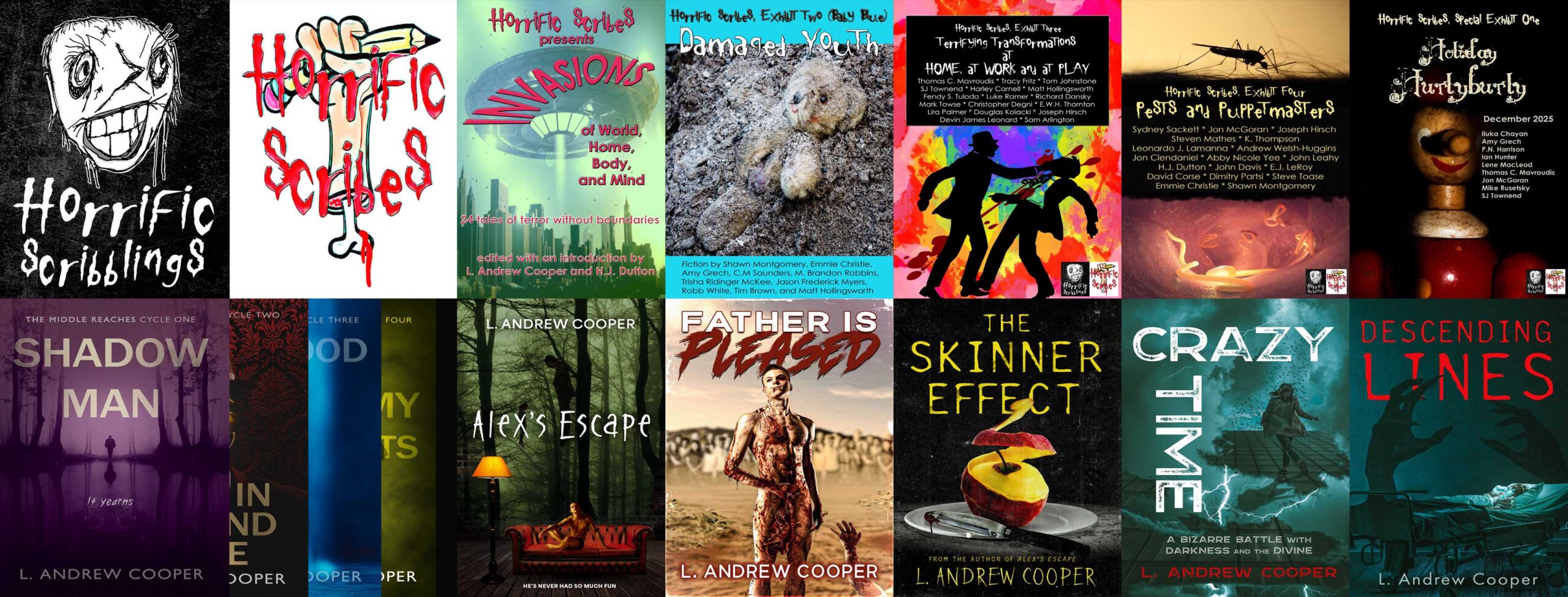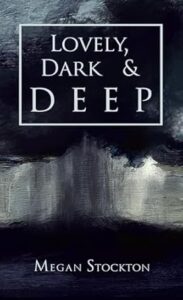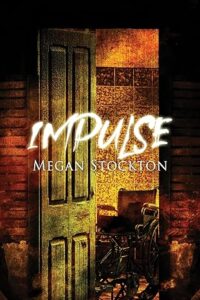Interview with Author Megan Stockton: Lovely, Dark & Deep and Impulse (2024)
A writer with range and diverse storytelling talents, Megan Stockton discusses the very different scares involved in two of her most recent works, Lovely, Dark & Deep and Impulse.
Lovely, Dark & Deep
Every year, Six Mile Island has a seasonal shutdown for serious weather. This year, the forecast is calling for the storm of a century, so most of the population has agreed to an evacuation to ride out the storm on the mainland. When a child goes missing on the cusp of the oceanic storm, a select few inhabitants are left behind to perform a frantic search. Little do they know that the ocean is bringing more than a storm to Six Mile… An ancient species hungers from the sea.
“Megan Stockton writes on a different plane than the rest of us. There’s poetry in her madness, and chilling sea songs sunk layers deep within her prose. Lovely, Dark & Deep is an oil spill. You’ll be tricked by Megan’s smooth writing because it’s as beautiful as the most vibrant iridescence, but within those sharp colors hides a story slick black and coated with oceanic trauma. This book is Megan’s best, and it’s a sneak peak into the future of indie horror.” Gage Greenwood, author of Bunker Dogs
“Surf, sand, and…blood? For those who love the beach, Megan Stockton will have you questioning your decision as the watery nightmares in Lovely, Dark, & Deep will haunt you well after you turn the last page.” Jay Bower, author of Cadaverous
“Our sonar is picking up an enormous talent rising up from the depths of the horror scene. Megan Stockton is a leviathan of a writer, and Lovely, Dark & Deep will surely be her breakthrough. Pray for us poor readers when this stunning novel makes landfall.” Clay Mcleod Chapman, author of Ghost Eaters
Impulse
Jason is having a midlife crisis, but not the kind where you go buy a boat or motorcycle. He’s been binging porn and meeting up with casual encounters at a nearby motel for months, and it just isn’t enough anymore. After scheduling another hookup, he picks up a hitchhiking teenage girl on the side of a desolate road. What first seems like an opportunity for him to take advantage of her quickly turns on its head when he realizes she is the real predator.
“An edge-of-your-seat, tension-filled ride that will have you regretting every wrong thing you’ve ever done.” Rayne Havok, author of the Killstreme series
“Stockton brings us a brutal page-turner that doesn’t go where you expect it to. Baby and Sassy are names you won’t soon forget!” – Jason Nickey, author of Rural Decay
The Interview
1. Lovely, Dark, Sensory Depth. Your writing in both books distinguishes itself with an emphasis on details that address all the senses, consistently going beyond sight and sound. In Lovely, Dark & Deep, I think of the smells, tastes, and feelings of the ocean and rainwater; in Impulse, I think more of the smells, tastes, and feelings of bodily secretions. Why do you concentrate so much on such diverse sensory details? Do you have a particular method that ensures you will address all the senses consistently? What do descriptions of smells, tastes, and tactile sensations add to stories—particularly horror stories?
MS: I have always felt like a hallmark of a good book is one that encourages you to imagine with more than just the visual sense. This lends itself to becoming a much more immersive experience. If you aren’t guiding your reader through every accessible sense, you’re missing out on really sinking your hooks into them and how they experience your story. For example, our sense of smell is strongly associated with memories, and so I can only assume that means it has a very significant impact on us emotionally. As a reader I love getting a phantom taste, smell, or sound as I’m imagining the scene around me. When I’m writing I document everything I encounter, and always try to involve every sense. I think this is especially important in horror because we are exposing our readers to a horrific fantasy that is specifically affecting because of the high emotion it elicits; we want the reader to forget they’re just reading a book. When they blink and realize they’re at home on the couch, you want the sensations to linger.
2. Structure and Suspense. Both books create outstanding suspense. Each has a major suspense-story arc, building through the narrative toward a big finish, as well as smaller arcs within scenes. While such arcs aren’t unusual, you construct yours with precision that creates very smooth and exciting rides. What’s the secret for writing effective suspense? For the larger arcs, how does withholding and revealing information about what’s happening (with the sea creatures in Lovely, with Baby and Sassy in Impulse) relate to the suspense of what will happen? For the smaller arcs, what techniques allow you to cut right into readers’ nerves?
MS: I don’t know if I have the secret for building effective suspense, but I tend to write from character POVs that are very limited. I want the reader to only know what the characters know. When you’re using alternating POVs, like I use in several of my books, you can expose the reader to just enough information that it raises the stakes with the next POV. So if we follow Character A through a dark tunnel, and the next chapter Character B gets a phone call that there are cannibal zombies in the cave below, you want to scream a warning when you return to the dark with Character A. It’s always easiest to give the reader all the information and leave nothing hidden, because as writers we want those reactions and emotions to boil to the surface as quickly as possible… but if you trust your reader to be patient and, maybe even more importantly, curious, then your payoff will be so much better when the reality sets in for them in the story.
3. Extremes. I first encountered your writing in Jonathan Butcher’s Your Loved Ones Will Die First, so I expected and found the “brutal” content lauded in both the description of your work above and in your bio below. Impulse more clearly follows hardcore protocols, but both books get pretty grisly—would you call either or both hardcore horror, and what’s the reasoning behind your categorization? Are you hardcore? What inspires the grisly moments? What makes gruesome good?
MS: I think as an individual I’m pretty far from hardcore haha. I love extreme horror both as a reader and as an author. I would say that my titles like Impulse and Bluejay lend themselves to being more on the hardcore spectrum simply because they indulge in those graphic moments. I could easily make something like Lovely, Dark & Deep more extreme just by leaning into those scenes a little more. There’s absolutely a place for both. I love describing things in unexpected ways. Using traditionally soft or “pretty” descriptors for something grisly or violent, for example, or blending sensory words in unusual fashion. For me, gruesome is best when the reader cares. If you feel something for the victim, whether positive or negative, the scene is going to have a heavier impact. Some people cringe, some people giggle and kick their feet… The goal is to make you feel something. You can’t just throw blood on a canvas and expect someone to scream… if you show them that it’s the blood of a loved one though… well, you get the idea.
4. Making a Monster I. The description of Lovely, Dark & Deep mentions an “ancient species” that “hungers from the sea,” but since you don’t use familiar sea-creatures, part of the book’s intrigue derives from learning about the creatures and the “rules” (as one character reflects) for how they operate. Comparisons to familiar monsters arise as the book reveals details about the monsters at hand, but your “ancient species” never loses its aura of mystery. How did you design your sea monsters? Which do you think is more powerful—both in the world of the story and in its impact on readers—their psychological or their physical impact? Why? A pastor provides an account about the first settlers of the book’s island setting that could amount to canonical monster lore—should readers take this passage as concrete insight into what the monsters are, do, and might do again in your future writing?
MS: The initial concept of Lovely, Dark & Deep (that is, the idea of vampiric creatures preying on an isolated town due to forces of nature) was heavily inspired by 30 Days of Night. I was tossing around ideas and was visiting a small island on vacation when a local told me that the entire island was only ten miles (or something) from end to end. I frequently write small town settings, and this was a small town isolated geographically by water, and the cast of characters is isolated drastically by the inclement weather. So I started the book with my mind on vampiric creatures, but I found myself wanting something a little more fresh than the tried and true vampires of literature. I decided to kind of create my own version of sirens; borrowing ideas from mermaids, sirens, draugr, and other legends. I truly feel like the emotional impact of these creatures is far more terrifying than their physical appearances. These are monsters wearing the skin of people that you once knew and loved, and in some ways they’re still those people but all of the most intense and passionate parts. The pastor’s tale of a similar situation happening years ago was just to set up the idea for the reader that this could all be a shared psychosis from toxicity or poisoning. Of course, that’s really a red herring… I also wanted to suggest that this had happened before but very, very long ago and had been passed off as a tragic natural accident.
5. Lovely, Dark, Perspectival Depth. Lovely, Dark & Deep switches from one character’s third-person limited perspective to another’s at each chapter break. Why did you choose this approach for this story? What did the alternation of perspectives contribute to the unfolding horrors? What challenges did it present? How did you establish different tones, moods, and internal voices to differentiate each recurring perspective character? One character is a young boy—how did you make his perspective authentic?
MS: I write most of my books in alternating POVs; it’s just my preferential storytelling mode. I love offering these variable viewpoints to a story without disclosing the thoughts of every character in the book. It also means that no one is truly safe, and even if you lose a POV character there’s still more to tell the story for us. I really just slip into the skin of whoever I’m writing and try to execute their unique “voice” even in the narrative portions of the story. The ways they view and interpret things are how they are delivered to the reader, down to the way they may describe or word something. In regard to the POV of Fisher, I have only written a child’s POV three times before as I find it the most difficult for me to pull off. I think that children can offer such a special view of situations, especially high stress and unusual circumstances like those in Lovely, Dark & Deep.
6. Queer Leads. In Lovely, Dark & Deep, two central perspective characters, arguably the leads, are tough, capable women who have a romantic history together that affects their interactions and major plot points. Why did you choose to put former same-sex lovers at the center of the story? The book doesn’t use words such as “lesbian,” “gay,” or “bisexual.” Why? A man interested in one of these women doesn’t seem fazed by her romantic history—in this fictional universe, can he safely presume pansexuality? Regardless of labels, what does putting strong, women-oriented women at the center do for your story?
MS: I didn’t have any motivation for making Lyra and Felix two women vs. making them a heterosexual ex-couple. When I write queer characters, I rarely put flashing lights and signs above their heads because before their sexuality they are just characters. I push for seeing both women and queer characters in every role imaginable, because (as I say so often) we don’t need more representation, we need better representation. I want it to feel just like every other character or relationship you’ve ever read, or maybe even better. These are complex characters with uncomfortable pasts together, real personality flaws just like everyone else, and I don’t want to give anyone time to balk at but they’re queer. I tried to suggest that Landon was just a young starstruck man and, despite knowing that Lyra was not interested in men, he hoped that he might eventually win her over someday. Just youthful ignorance and puppy love. I think some people still shy away from female-led stories, especially in horror, but I want it to be unavoidable if you’re reading good books. I write plenty of male characters, and some of my books are led by a nearly entirely male cast, but we need more books in our genre that feature strong female leads who are strong because of, and not in spite of, being a woman.
7. Fight or Flight and Other Impulses. At several points in Lovely, Dark & Deep, the narrative refers directly to characters reacting to their fight or flight responses, biological impulses in reaction to danger. Why does your writing cut down to such a physical level when describing characters’ behaviors? The title of your more recent book, Impulse, seems to point to primal responses, too. What’s impulsive about Impulse—what basic behavioral motivations does it map? How does your treatment of character psychology in Lovely, Dark & Deep compare to that in Impulse?
MS: I usually call this point of desperation being “reduced to teeth.” I find that I’m really fascinated by the response of otherwise normal people in situations like these and how unexpectedly people will react when faced with unimaginable terror. Beneath it all, we’re all driven by these very basic instincts, but we all handle those urges and desires differently, and I think that alone often makes for an impactful story. I like to focus more on the fear of who you may become rather than what is driving you to that turning point. In Impulse, I think the entire story is about men acting on their primitive and selfish urges, and that drives the entire chain of events. The biggest difference between Impulse and Lovely, Dark & Deep is that everyone in LD&D is generally good at their core. Even when they make selfish choices or bad decisions, they’re still good people. There are no good people in Impulse. We want every terrible thing that happens to Jason to continue far beyond the end of the book, and maybe we even root for Sassy and Baby and their special brand of vengeance… but at the end of the day, evil is just a coin with two faces, and regardless of how you flip it, it spends the same.
8. Making a Monster II. Impulse is more grounded in “realism” in that it lacks supernatural elements, but that doesn’t mean it lacks monsters, or at least creatures—this time, people—who do very bad things to people. How did you design Jason, Baby, and Sassy? Being people, they’re not inclined to see themselves as monsters, and they might not be. Jason, for instance, insists that he’s good, or at least too good for what happens. How much moral ambiguity do you think really surrounds your characters who do monstrous things? If a reader sympathizes with one of your characters, does the reader share in monstrosity?
MS: There’s no argument that the things that Jason, Fuzz, and Sugarman did were disgusting and wrong. Jason doesn’t see what he has done in the past as being anything more than misunderstood. He doesn’t even consider the moral implications, or how it affects the people involved or around him. In the beginning, he considers how every four years he gets a new set of victims, and he can forget about the ones who have left… but of course, as we see later on, he is faced with the lasting effects of the abuse he has dished out over the years. I like still giving these atrocious characters humanity, slipping in little things that the reader may identify with. In another one of my works, Bluejay, I introduce three of the most average guys who you probably can see you and your friends in… and then when they’re “reduced to teeth” you wonder if that could be you in the right circumstances. I hope no one sees much of themselves in Jason, but I think the moral dilemma of how much he deserves what’s happening to him can give us a peek into our own psyche. Are Sassy and Baby our antagonists? Antiheroines? Vigilantes? Are they just as much villains as Jason? I initially was going to make this alternating POVs as well but liked limiting the view to Jason to give the more unusual view of the “bad guy” at the hands of the (sort of?) good guys.
9. Turning Tables on Men. Impulse begins with epigraphs from the film I Spit on Your Grave (1978), probably the best-known entry in the rape/revenge cycle of films from its time, and from Jonathan Butcher’s novella What Good Girls Do, a contemporary juggernaut of hardcore horror involving the abuse of women and its consequences. These references create an expectation that your perspective character, Jason, who seems like an abusive creep, might meet some horrifying comeuppance at the hands of women. Does Jason reflect more generally on patriarchy and its support and protection of abusive creeps? Unlike a typical rape/revenge story, your tale doesn’t begin with any details of abuse that the seemingly vengeful women Jason meets, Baby and Sassy, have experienced. Their motives therefore seem more abstract. When they go after Jason, do you see them going after men, seizing the control usually limited to men, and correcting a more global imbalance? Why or why not? Would you consider this book feminist? Why or why not?
MS: Given his POV we downplay everything that he’s done, mention it in passing like it’s no big deal. Baby and Sassy are the women from that cycle of abuse who, after years of silence, decide to turn the abuse back onto the men who hurt them. Jason, Fuzz, and Sugarman were met with the monsters that they created, and they still didn’t think they deserved it. At the end it’s revealed that Sassy and Baby bring in another victim to let her have a taste of revenge, too. There are dozens of books where the entire plot centers around women being raped or tortured, so I think, yeah, maybe putting a man in that position could be considered a little bit of a feminist stand on the torture porn-ish trope. Guy vics are still not super common, especially at the hands of female characters. Instead of making him a sympathetic victim of two psychopaths, I hoped this could feel cathartic to women that have experienced similar abuse and wished they could get the same kind of revenge.
*BONUS QUESTION* Is Jason’s last name, Burnham, a reference to the Kevin Spacey character in the film American Beauty (1999)?
MS: YES!
10. Access! How can readers learn more about you and your works (please provide any links you want to share)?
MS: You can get my books, merch, etc here: http://www.meganstocktonbooks.com
Join the Patreon to read my books as they’re written and hang out with me and the rest of the Bad Luck Cat Club on Facebook. http://www.patreon.com/badluckcatclub
About the Author
Megan Stockton is an indie author who lives in rural Middle Tennessee with her husband and two children. She primarily writes dystopian, horror, thriller, and science fiction/fantasy novels that are character-driven and immersive. She is known for delivering works that are raw, thought-provoking, brutal, and cinematic.




